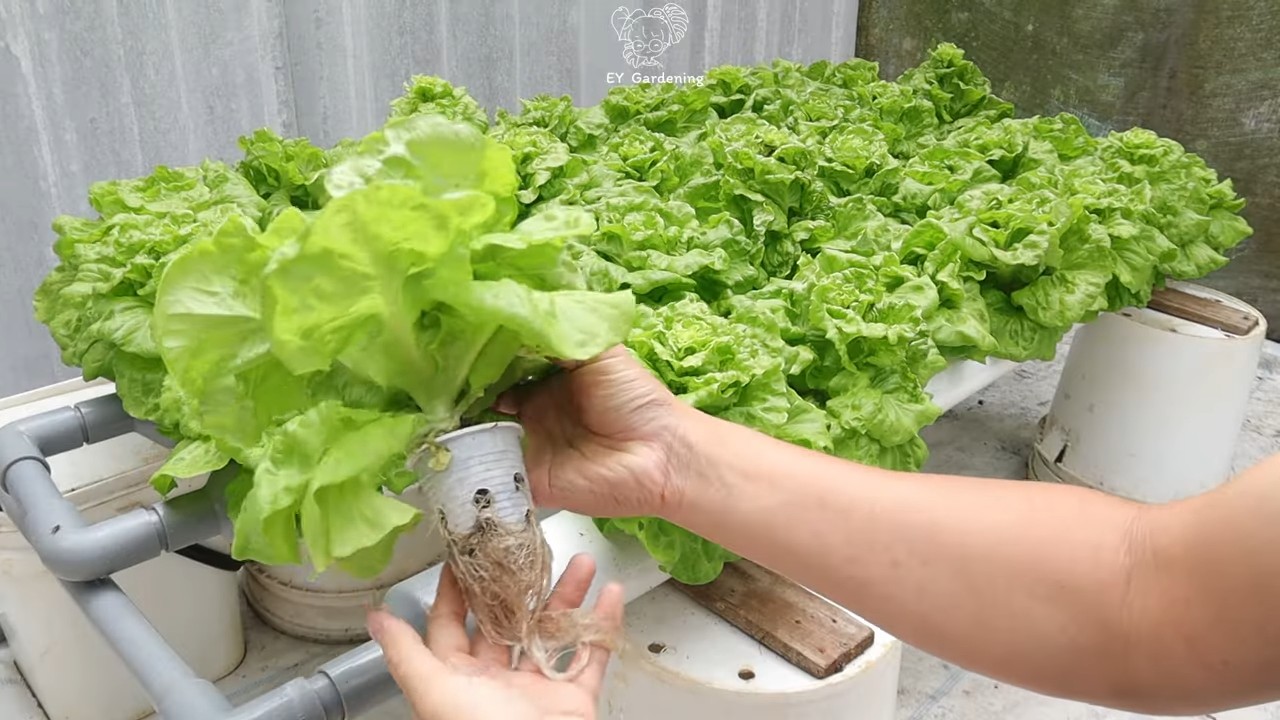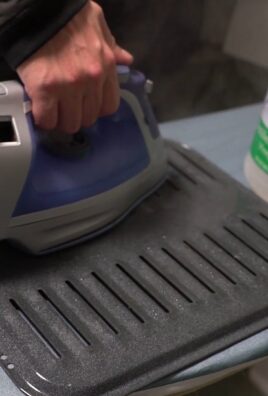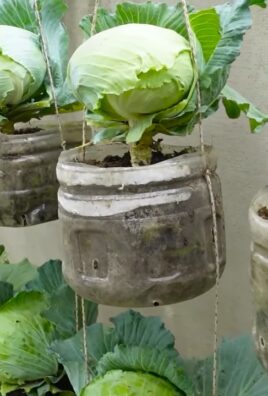Water Only Lettuce Growing: Imagine harvesting crisp, fresh lettuce right from your kitchen counter, without ever touching soil! Sounds like something out of a sci-fi movie, right? Well, get ready to be amazed because I’m about to share a simple yet revolutionary DIY trick that will transform the way you think about growing lettuce.
Hydroponics, the art of growing plants without soil, has been around for centuries, with evidence suggesting its practice in ancient civilizations like Babylon and Egypt. While large-scale hydroponic farms might seem intimidating, this method has been simplified for home gardeners like us. This isn’t just a trend; it’s a sustainable and space-saving solution for fresh produce.
In today’s fast-paced world, finding time and space for a traditional garden can be a challenge. That’s where this water only lettuce growing hack comes in. It’s perfect for apartment dwellers, busy professionals, or anyone who wants to enjoy the taste of homegrown lettuce without the hassle of weeding, soil preparation, or pest control. Plus, it’s a fantastic way to reduce your carbon footprint and enjoy healthier, fresher greens. So, are you ready to ditch the dirt and dive into the world of water-based lettuce cultivation? Let’s get started!

Gardening Made Easy: Grow Lettuce with Just Water!
Hey folks, do you fancy fresh lettuce but have no space for a large garden bed or don’t feel like dealing with complicated growing methods? Then I have just the thing for you! I’m going to show you how to grow lettuce easily with just water. Yes, you heard that right – no soil, no fertilizer, just water! Sounds crazy? But it’s not! And it’s super satisfying to see fresh leaves sprout from a lettuce stalk.
What you need:
- Lettuce stalk: Preferably from Romaine or head lettuce. Make sure the stalk is still intact and not mushy.
- Container: A glass, a bowl, or a cup that is large enough to hold the stalk.
- Water: Tap water is perfectly sufficient.
- Sunlight: A bright spot is important, but you should avoid direct midday sun.
- Patience: It takes a few days for the first leaves to sprout.
Step-by-Step Guide:
- Prepare the lettuce: After you’ve eaten the lettuce, cut the stalk about 5-7 cm (2-3 inches) above the root. Carefully remove the outer, wilted leaves so that only the firm core remains.
- Prepare the container: Fill your container with water. Make sure the water level is not too high. The stalk should only be standing in about 2-3 cm (about 1 inch) of water to prevent it from rotting.
- Place the lettuce stalk: Place the lettuce stalk with the cut surface facing down into the water. Make sure it stands stable and doesn’t tip over.
- Choose a location: Place the container in a bright spot, but avoid direct sunlight, especially at noon. An east or west-facing windowsill is ideal.
- Change the water: Change the water every 1-2 days to prevent the formation of bacteria and algae. The fresh water also supplies the lettuce stalk with oxygen.
- Be patient: After a few days, you should see the first small leaves. It can take up to two weeks for the lettuce to form enough leaves to be harvested.
Harvest and Care:
- Harvesting: When the leaves are large enough, you can carefully pick them. Leave the heart of the lettuce intact so it can continue to grow.
- Fertilizing (optional): If you wish, you can occasionally add a drop of liquid houseplant fertilizer to the water. However, this is not strictly necessary.
- Preventing mold: Make sure the stalk does not rot or mold. If you see signs of mold, remove the stalk immediately and clean the container thoroughly.
- Transplanting (optional): If the lettuce has grown well, you can also transplant it into a pot with soil. This will provide it with more nutrients and allow it to grow even larger.
Common Problems and Solutions:
- The stalk is rotting: This usually happens if the stalk is too deep in the water or if the water is not changed regularly. Make sure only the bottom cut surface is in the water and change the water every 1-2 days.
- The lettuce isn’t growing: This can have various causes. The lettuce might not be getting enough light, or the water might be too cold. Move the lettuce to a brighter spot and ensure the water is at room temperature.
- The leaves are turning yellow: This can be a sign of a nutrient deficiency. Add a drop of liquid houseplant fertilizer to the water.
- Mold formation: As mentioned, changing the water regularly is important to prevent mold. If you discover mold, remove the stalk immediately and clean the container thoroughly.
Tips and Tricks for Success:
- Choose the right lettuce variety: Romaine and head lettuce are particularly well-suited for this method. Other types of lettuce might also work, but the results may not be as good.
- Use a fresh lettuce stalk: The fresher the lettuce stalk, the better the chances that it will sprout again.
- Be patient: It can take a few days for the first leaves to sprout. Don’t give up if you don’t see immediate results.
- Experiment: Try out different containers and locations to find out what works best for you.
- Document: Take photos of your lettuce to track its progress. This is not only motivating but also helps you to identify and correct mistakes.
Why This Method is So Great:
- Simple and straightforward: You don’t need any special skills or materials to grow lettuce with just water.
- Sustainable: You are recycling the lettuce stalk and avoiding food waste.
- Cost-effective: You save money since you don’t have to buy new lettuce.
- Space-saving: You can grow lettuce even in the smallest of spaces.
- Satisfying: It’s a great feeling to see fresh leaves sprout from a lettuce stalk.
A Few More Ideas:
- Different lettuce varieties: Try out different types of lettuce to see which ones work best.
- Herbs: You can also try to grow herbs like basil or mint with just water.
- Decoration: Use pretty containers and decorate your lettuce to make it an eye-catcher.
- Gift idea: Give a lettuce stalk with a nice container and instructions to friends or family.
I hope this guide has inspired you to try it yourself. It’s really child’s play and a lot of fun! Let me know how it worked out for you and share your experiences in the comments. Happy gardening

Conclusion
So, there you have it! Growing lettuce using only water might seem like a futuristic farming technique reserved for NASA, but it’s surprisingly accessible and rewarding for the everyday gardener. We’ve walked you through the simple steps, highlighted the benefits, and addressed potential challenges. But why is this DIY trick a must-try?
Firstly, it’s incredibly space-saving. Forget sprawling garden beds; a simple container on your windowsill or balcony is all you need. This makes it perfect for apartment dwellers, urban gardeners, or anyone with limited outdoor space. Secondly, it’s remarkably efficient. You’ll be amazed at how quickly your lettuce grows in a water-only environment, often outpacing traditional soil-based methods. This means fresher, tastier lettuce on your table in a fraction of the time. Thirdly, it’s a fantastic way to reduce waste. By repurposing plastic containers and minimizing water usage, you’re contributing to a more sustainable lifestyle.
But the real magic lies in the flavor. Lettuce grown in water tends to be crisper, sweeter, and more delicate than its soil-grown counterpart. This is because the plant has direct access to the nutrients it needs, resulting in optimal growth and flavor development.
Looking for variations? Absolutely! Experiment with different types of lettuce. Romaine, butterhead, and loose-leaf varieties are all excellent candidates for water-only growing. You can also add a diluted hydroponic nutrient solution to the water to boost growth and nutrient content, but remember to start with a very weak solution and gradually increase the concentration as needed. Consider using different containers – mason jars, repurposed plastic bottles, or even a dedicated hydroponic system. The possibilities are endless!
Don’t be afraid to get creative and personalize your water-only lettuce garden. Try adding a small air pump to oxygenate the water, which can further enhance growth. You can also experiment with different lighting conditions to see what works best for your specific environment.
Ultimately, the best way to discover the joys of water-only lettuce growing is to dive in and try it yourself. It’s a fun, educational, and rewarding experience that will provide you with a constant supply of fresh, delicious lettuce. We are confident that you will find this method of water only lettuce growing to be a game changer.
So, grab a container, some lettuce seeds, and get started today! We’re eager to hear about your experiences. Share your photos, tips, and challenges in the comments below. Let’s build a community of water-only lettuce growers and learn from each other. Happy growing!
Frequently Asked Questions (FAQ)
What exactly is water-only lettuce growing, and how does it work?
Water-only lettuce growing, also known as hydroponic lettuce growing without added nutrients, is a method of cultivating lettuce using only water as the growing medium. The lettuce seeds are germinated and the seedlings are supported in a way that their roots are submerged in water. The plant then absorbs the necessary moisture and, to a limited extent, any naturally occurring minerals present in the water. While it’s true that lettuce needs nutrients to thrive, the initial stages of growth can be supported by the seed’s own reserves and trace minerals in the water. This method is most effective for short-term growth and harvesting baby lettuce leaves. For more mature heads of lettuce, supplemental nutrients are generally required.
What kind of water should I use for water-only lettuce growing?
The best type of water to use is filtered or purified water. Tap water can sometimes contain chlorine or other chemicals that can be harmful to lettuce seedlings. If you must use tap water, let it sit out for 24 hours to allow the chlorine to evaporate. Rainwater is also a good option, as it is naturally soft and free of chemicals. Avoid using distilled water, as it lacks essential minerals that the lettuce needs, even in small amounts. Spring water is also a good choice, as it contains natural minerals that can benefit the lettuce.
How often should I change the water?
It’s crucial to change the water regularly to prevent the buildup of algae and bacteria. Ideally, you should change the water every 2-3 days. If you notice the water becoming cloudy or discolored, change it immediately. When changing the water, gently rinse the roots of the lettuce to remove any debris. This will help to keep the roots healthy and prevent disease.
What type of container is best for water-only lettuce growing?
You can use a variety of containers for water-only lettuce growing. Plastic containers, glass jars, and even repurposed plastic bottles can work well. The most important thing is to choose a container that is clean and opaque. Opaque containers help to prevent algae growth by blocking out light. Make sure the container is deep enough to accommodate the roots of the lettuce. A container that is at least 4-6 inches deep is ideal.
How do I support the lettuce seedlings in the water?
There are several ways to support the lettuce seedlings in the water. One common method is to use a piece of Styrofoam or cardboard with holes cut out to hold the seedlings. The roots of the seedlings should be submerged in the water, while the leaves should be above the water line. You can also use net pots filled with inert growing media like perlite or vermiculite to support the seedlings. The net pots can then be suspended in the water.
What kind of lighting is required for water-only lettuce growing?
Lettuce needs adequate light to grow properly. If you are growing your lettuce indoors, you will need to provide supplemental lighting. Fluorescent lights or LED grow lights are good options. Place the lights about 6-12 inches above the lettuce seedlings. Aim for at least 12-14 hours of light per day. If you are growing your lettuce outdoors, choose a location that receives at least 6 hours of sunlight per day.
Can I add nutrients to the water?
While the focus is on water-only growing, adding a very diluted hydroponic nutrient solution can boost growth, especially for larger lettuce heads. However, it’s crucial to start with a very weak solution (1/4 or even 1/8 of the recommended strength) and gradually increase the concentration as needed. Monitor the lettuce closely for any signs of nutrient burn, such as yellowing or browning of the leaves. If you notice any signs of nutrient burn, reduce the concentration of the nutrient solution or switch back to plain water.
What are some common problems with water-only lettuce growing, and how can I fix them?
Some common problems include algae growth, root rot, and nutrient deficiencies. Algae growth can be prevented by using an opaque container and changing the water regularly. Root rot can be caused by poor water quality or lack of oxygen. To prevent root rot, change the water frequently and consider adding a small air pump to oxygenate the water. Nutrient deficiencies can be addressed by adding a very diluted hydroponic nutrient solution to the water.
How long does it take to grow lettuce using the water-only method?
The time it takes to grow lettuce using the water-only method depends on the variety of lettuce and the growing conditions. In general, you can expect to harvest baby lettuce leaves in about 2-3 weeks. For larger heads of lettuce, it may take 4-6 weeks. Keep in mind that growth rates can vary depending on the amount of light, temperature, and water quality.
Is water-only lettuce growing sustainable?
Yes, water-only lettuce growing can be a very sustainable method of gardening. It uses less water than traditional soil-based gardening, and it can be done in small spaces, making it ideal for urban gardeners. By repurposing plastic containers and minimizing waste, you can further reduce your environmental impact. Furthermore, growing your own lettuce reduces the need to purchase lettuce from the grocery store, which can save you money and reduce your carbon footprint.




Leave a Comment